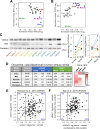VDAC2 and Bak scarcity in liver mitochondria enables targeting hepatocarcinoma while sparing hepatocytes
- PMID: 40069152
- PMCID: PMC11897174
- DOI: 10.1038/s41467-025-56898-4
VDAC2 and Bak scarcity in liver mitochondria enables targeting hepatocarcinoma while sparing hepatocytes
Abstract
Differences between normal tissues and invading tumors that allow tumor targeting while saving normal tissue are much sought after. Here we show that scarcity of VDAC2, and the consequent lack of Bak recruitment to mitochondria, renders hepatocyte mitochondria resistant to permeabilization by truncated Bid (tBid), a Bcl-2 Homology 3 (BH3)-only, Bcl-2 family protein. Increased VDAC2 and Bak is found in most human liver cancers and mitochondria from tumors and hepatic cancer cell lines exhibit VDAC2- and Bak-dependent tBid sensitivity. Exploring potential therapeutic targeting, we find that combinations of activators of the tBid pathway with inhibitors of the Bcl-2 family proteins that suppress Bak activation enhance VDAC2-dependent death of hepatocarcinoma cells with little effect on normal hepatocytes. Furthermore, in vivo, combination of S63845, a selective Mcl-1 inhibitor, with tumor-nectrosis factor-related, apoptosis-induncing ligand (TRAIL) peptide reduces tumor growth, but only in tumors expressing VDAC2. Thus, we describe mitochondrial molecular fingerprint that discriminates liver from hepatocarcinoma and allows sparing normal tissue while targeting tumors.
© 2025. The Author(s).
Conflict of interest statement
Competing interests: C.B.T. is a founder of Agios Pharmaceuticals and a member of the Board of Directors of Regeneron and Charles River Laboratories. The remaining authors declare no competing interests.
Figures







References
-
- Colombini, M. The VDAC channel: molecular basis for selectivity. Biochimica et. biophysica acta1863, 2498–2502 (2016). - PubMed
-
- Becker, T. & Wagner, R. Mitochondrial outer membrane channels: emerging diversity in transport processes. BioEssays: N. Rev. Mol., Cell. developmental Biol.40, e1800013 (2018). - PubMed
